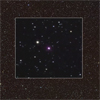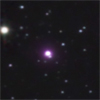CXC Home | Search | Help | Image Use Policy | Latest Images | Privacy | Accessibility | Glossary | Q&A
Tour of CoRoT-2A
Quicktime MPEG
In recent years, astronomers have found hundreds of planets orbiting stars other than our Sun. New Chandra observations of one of these planets reveal that it is in a fairly dire situation. The Chandra data provide evidence that the star in this system, known as CoRoT-2a, is blasting a planet that is in an extremely close orbit around it with very powerful X-rays. These X-rays are a hundred thousand times more intense than those that the Earth receives from the Sun, and are causing some serious damage. Astronomers estimate that this high-energy radiation is evaporating about 5 million tons of matter every second from the planet. Future observations with Chandra and other telescopes should reveal more details about what's going on in this system and perhaps others like it. In the meantime, let's be happy that the Earth isn't anything like this fried planet.
[Runtime: 01:00]
Quicktime MPEG
In recent years, astronomers have found hundreds of planets orbiting stars other than our Sun. New Chandra observations of one of these planets reveal that it is in a fairly dire situation. The Chandra data provide evidence that the star in this system, known as CoRoT-2a, is blasting a planet that is in an extremely close orbit around it with very powerful X-rays. These X-rays are a hundred thousand times more intense than those that the Earth receives from the Sun, and are causing some serious damage. Astronomers estimate that this high-energy radiation is evaporating about 5 million tons of matter every second from the planet. Future observations with Chandra and other telescopes should reveal more details about what's going on in this system and perhaps others like it. In the meantime, let's be happy that the Earth isn't anything like this fried planet.
[Runtime: 01:00]
(Credit: NASA/CXC/A. Hobart)
X-ray and Optical Images of CoRoT-2A
Quicktime MPEG
This sequence shows images of a nearby star named CoRoT-2a. The composite image contains X-rays from Chandra (purple) of CoRoT-2a along with optical and infrared data of the field of view in which the star is found. Not seen in these images -- but still detectable in the data -- is a planet known as CoRoT-2b in an extremely close orbit around the star. The Chandra data indicate that the planet is being blasted by X-rays with such intensity that some 5 million tons of material are being eroded from CoRoT-2a every second.
[Runtime: 00:28]
Quicktime MPEG
This sequence shows images of a nearby star named CoRoT-2a. The composite image contains X-rays from Chandra (purple) of CoRoT-2a along with optical and infrared data of the field of view in which the star is found. Not seen in these images -- but still detectable in the data -- is a planet known as CoRoT-2b in an extremely close orbit around the star. The Chandra data indicate that the planet is being blasted by X-rays with such intensity that some 5 million tons of material are being eroded from CoRoT-2a every second.
[Runtime: 00:28]
(Credit: NASA/CXC/A. Hobart)
Return to CoRoT-2A (September 13, 2011)




